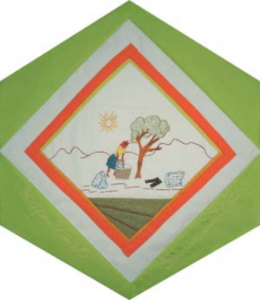Cabo Verde

The Block
This colourful scene, embroidered by Gloria Hanck, depicts a woman, protected by the shade of a majestic tree, performing one of her daily tasks. Freshly washed clothes, held down with rocks so as not to blow away, dry under the blistering rays of the midday sun. Rising peaks of the islands’ mountainous terrain can be seen in the distance, while printed fabrics replicate the arid landscape. Gloria wanted to show one of the many familiar scenes of the chores of Cabo Verde’s women. These scenes are often depicted in the arts and crafts produced locally. Whether it is creating a piece of embroidery, pounding corn or, as seen in this block, doing the family’s laundry, these chores make up the durable fabric of each community. Gloria felt that the hard work done by men and women of the archipelago should therefore be placed at the center of the block.
Cultural Profile
The Republic of Cabo Verde, one of the world’s smallest nations, is situated in the Atlantic Ocean approximately 640 kilometres (400 miles) northwest of Senegal. It consists of five islets and ten islands, which are divided into Barlavento (Winward group) and Sotavento (Leeward group). The islands are volcanic in origin and all but three are mountainous. Pico do Cano, which is located on Fogo in Sotavento, is the group’s highest point as well as its only active volcano. More than two-thirds of Cabo Verde’s inhabitants are Creoles or Mestiços (mixed African and European ancestry) and nearly all of the remainder are of African descent. The country declared independence from Portugal in 1975. The official language is Portuguese although most people speak an informal Créole tongue known as Crioulo.
Agriculture is an important economic activity on the islands involving roughly one-quarter of the working population. However, it is vulnerable to periodic droughts which afflict the islands. Chief crops include maize and beans, as well as coconuts, sugarcane, potatoes, sweet potatoes, cassava and dates. Wine production is also being developed and has garnered international attention. Fishing for tuna and lobster is also an important, although not a fully developed industry. The island’s catches constitute almost half of its total export earnings. The country has enjoyed stability and a steady economic growth in the past decades. Tourism now accounts for a large part of the economic activity as the islands are located at the crossroads of many air and sea lanes. Many cruise ships now stop in the harbours of Mindelo and Praia as tourists enjoy the sandy beaches, the mountain scenery and the islands’ unique culture.
Cabo Verde’s culture is a reflection of both European and African influences. There is a valuable tradition of literature and a folklore that includes a wealth of stories, proverbs and customs. Music is an essential part of community life and includes such styles as the foot-stomping funana or the fast-moving coladeira. The late Cesária Évora, one of the most famous Cabo Verdeans, has been a worldwide ambassador of the country’s national songform, the nostalgic morna. The islanders are also known for cane baskets, which are used for both practical and decorative purposes, traditional white and indigo blue cotton goods, pano weaving, wood sculptures and red clay ceramics.
Cabo Verde has experienced large emigration for years as a result of the islands’ shortage of natural resources and frequent droughts––more people of Cabo Verdean ancestry now live outside the country than inside it. Cabo Verdeans have travelled the world to find work. The United States, Portugal, Angola, São Tomé and Príncipe, Senegal and the Netherlands are countries with large Cabo Verdean communities. The archipelago’s economy benefits greatly from remittances sent each year by Cabo Verdeans living abroad.
Cabo Verdeans have been coming to Canada since the early 1960s, when the islands were going through one the worst famines in their history. There numbers remain very small and they have generally settled in major cities, including Toronto, Montreal and Vancouver where they have contributed to the Canadian fabric in professions such as nursing and social work, as well as the food industry.
Sponsor: Paul A. Smith
